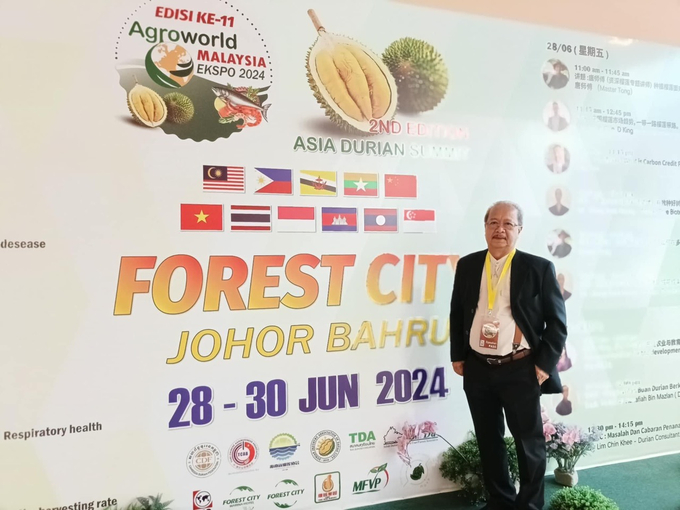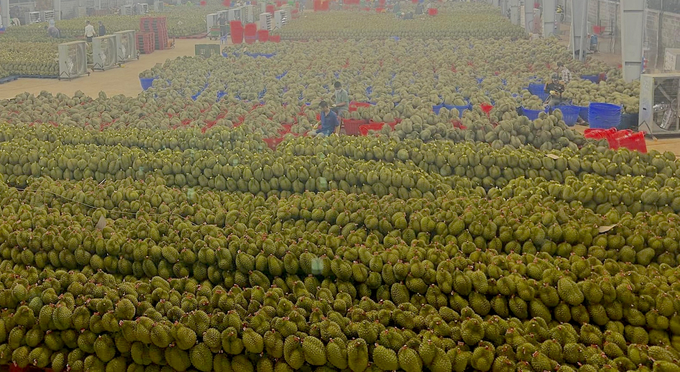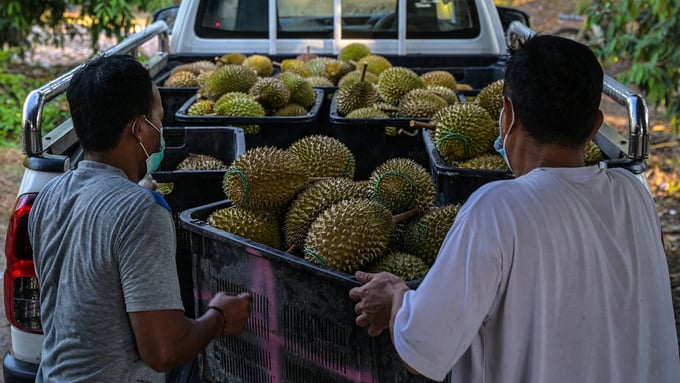November 19, 2025 | 00:30 GMT +7
November 19, 2025 | 00:30 GMT +7
Hotline: 0913.378.918
November 19, 2025 | 00:30 GMT +7
Hotline: 0913.378.918

Durian expert Sakda Sinives attended the 2nd Asian Durian Conference in Johor Bahru, Malaysia.
On June 28 in Johor Bahru, Malaysia, within the framework of the 2nd Asian Durian Conference, Thai agricultural expert Sakda Sinives analyzed the trends of the durian market in China. Below is his speech at the Conference.
It is well known that China is the largest market for durians from ASEAN countries.
In 2023, China imported a significant amount of durians, totaling over 1,425,922 tons, marking a continuous increase from previous years. The demand for durians in the Chinese market is expected to grow in the future, driven by their rising popularity among Chinese consumers. Although there is no clear data on the number of Chinese people consuming durians each year, it can be said that durians are highly popular in China, especially in major cities like Beijing, Shanghai, and Guangzhou.
Given the large imports of durians in recent years, it is estimated that millions of people in China consume durian annually, reflecting the trend of increasing consumption of tropical fruits among Chinese consumers. As the popularity of durians grows yearly, it is expected that the peels and seeds of durians will contribute to increasing waste problems, as durians have an edible portion of only about 30-35% of their total weight, with the remaining 65-70% being inedible peels and seeds.

Durian packaging factory in Thailand. Photo: Sakda Sinives.
According to China's customs data in 2023, China imported 928,976 tons of fresh durians from Thailand, 493,183 tons from Vietnam, and 3,763 tons from the Philippines, totaling 1,425,922 tons. This results in approximately 456,295 tons of edible durian flesh and about 969,627 tons of inedible waste. This massive amount of biological waste requires proper treatment in China. The organic waste from durian peels can cause various forms of pollution, including:
1. Greenhouse gases:
- Methane (CH₄) from anaerobic decomposition of organic waste in landfills.
- Carbon dioxide (CO₂) from aerobic decomposition.
- Nitrous oxide (N₂O) from nitrogen decomposition in organic waste.
2. Foul odors: Decomposition of organic waste releases unpleasant odors, causing annoyance and health issues.
3. Water pollution: Leachate from decomposing waste can contaminate water sources, affecting the environment and human health.
4. Hygiene problems: Accumulated organic waste can breed flies and vermin like rats, spreading diseases.
Given that only 30-35% of a durian is edible and 65-70% is waste, exporters to China incur transportation costs for this waste. Assuming transportation costs for a fresh durian container (18 tons) from eastern Thailand to Jiangnan Market, Guangdong Province, are $10,000 per trip, exporters lose $6,500-7,000 per container on waste transport. With approximately 50,000 containers exported from Thailand in 2023, this translates to a transportation cost of $325-350 million (11.7-12.6 billion THB) for waste alone.

Exporters need to comply with China's strict regulations on reducing bio-waste from durian peels. Illustration photo.
Therefore, exporting only the edible portion of durians to China can significantly reduce transportation costs and waste, increasing profits and export value. This would also provide Thai farmers with a more stable income from durian sales, allowing them to focus on quality and flavor rather than size. It would reduce the use of chemicals for pest and disease control, ensuring safer produce for consumers and a healthier environment for farmers. Additionally, farmers could convert organic waste into affordable compost, benefiting agriculture and reducing greenhouse gas emissions.
Meanwhile, changing consumer behaviors among the younger generation, with smaller households and faster-paced lives, increases the demand for convenience. Selling pre-cut or frozen durian flesh suits modern consumers, aligning with online and platform-based sales and efficient logistics. Consumers can buy according to their desired quantity and preferences, reducing the risk of purchasing whole durians with unknown flesh quality.
Therefore, the market direction for fresh-cut durians in China and globally is a promising future trend, influenced by market mechanisms and consumer preferences, particularly the Chinese government. China is aware of the waste problem from durian peels, but the benefits for relevant authorities between fresh and pre-cut durians vary. Importing pre-cut durians changes the import category from agricultural products to food, affecting customs revenue and trade or political leverage related to phytosanitary issues.
This shift is inevitable, and its timing depends on the aforementioned conditions.
Translated by Quynh Chi

(VAN) 'If we can address disease challenges and properly plan farming zones, Vietnamese shrimp can absolutely rise to lead the world,' Mr. Le Van Quang affirmed.

(VAN) The year 2025 continues to mark a significant footprint for Chanh Thu Fruit Import-Export Group Joint Stock Company (Chanh Thu Group) in the international market.

(VAN) Participating in the exhibition celebrating the 80-year tradition of the Agriculture and Environment sector, Dong Giao Food Export Joint Stock Company (DOVECO) showcased a range of products utilizing new technologies.

(VAN) Vietnam’s pepper export turnover in the first 10 months of 2025 reached $1.39 billion, already surpassing the full-year figure of 2024.

(VAN) AGRITECHNICA 2025 has impressively reaffirmed its position as the world’s leading trade fair for agricultural machinery.
/2025/11/17/4947-2-104601_225.jpg)
(VAN) The international market is growing rapidly, creating major opportunities for Viet Nam's tilapia industry.
/2025/11/17/1234-2-010716_981.jpg)
(VAN) Deputy General Director of Viet Nhat Group Nguyen Dang Ngoc shared experiences on building linkage chains and developing sustainable tilapia farming that meets international standards.